After the star pattern of the Argo was split, Hydra became the largest constellation in the sky. It is an extraordinarily long constellation, stretching more than six hours in rectangular time, across 1/4 of the celestial sphere, roughly below the ecliptic. The head of Hydra borders the Canis Minor on its western edge, so it can be observed even on winter evenings. The tail winds under the Sextant, Crater, Corvus, Virgo, and ends up under the constellation Libra, which is a transitional constellation between spring and summer. One could almost say that when the head of Hydra sets, the tail is just rising. This is especially so in northern Europe. The head of Hydra is an attractive and striking stellar cluster of the constants δ, ε, ζ, η, ρ and σ Hydra (which have nothing in common with each other apart from this) lying north of the celestial equator, which fits within the field of view of most 7×50 binoculars. Its heart is formed by the red-orange star Alfard. The winding tail, best seen on clear dark nights because it contains mostly only 4-5mag stars, ends at the star 58 Hydra, southwest of σ Librae of Libra.
Although the constellation extends outside the Milky Way, its size means that it contains a variety of remarkable objects. Most of these are galaxies, of course, but many are brighter than 10mag. Hydra also contains some nice planetary nebulae, a couple of globular clusters and one nice open cluster. Three objects are also in Messier's catalogue: M48, M68 and M83. The constellation also contains the galaxy cluster Hydra, one of the densest galaxy clusters. Its brightest member is the galaxy NGC 3311 (10.9mag).
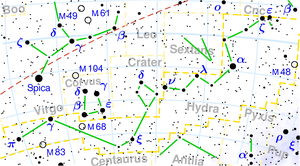
Alfard (α Hya) - The brightest star of the constellation, located on the line connecting the stars Castor - Pollux of Gemini. Its remarkable orange color can certainly be noticed with the naked eye, and it belongs to the spectral class K3. This star has a magnitude of 2 and is located in an area relatively poor in stars. That is why its translated name from Arabic means "Lonely Star". However, Tycho de Brahe called it Cor Hydraul - "Heart of the Hydra". It is located at a distance of 177 light years and is 780 times more luminous than the Sun.
ε Hya - The main component with a brightness of 3.8mag has a companion with a brightness of 6.9mag at a separation of 2.8". To resolve this binary star, we need a telescope with an objective diameter of at least 8 cm. The components orbit each other every 870 years and are located at a distance of 129 light-years.
U Hya - One of the brightest and most unusual carbon stars, whose red color can be seen even in the smallest telescope. This is due to the abundance of carbon molecules in its atmosphere, which absorb blue light. U Hya is observed 4 degrees northwest of the star ν Hydra and belongs to the irregular variable stars, whose magnitude fluctuates regularly from 4.7mag to 6.2mag in a period of about 450 days. It is located approximately 680 light-years away.
τ1 Hya - The components with magnitudes of 4.8 and 8 lie at a separation of 65". It is an optical double star, which can be resolved even with a simple telescope.
54 Hya - The double star is composed of components with magnitudes 5.1 and 7.1, which can be easily distinguished even with small telescopes at a separation of 8.6". Notice the color of both stars, one is bright and the other is dark yellow.
R Hydrae - The red giant, one of the most famous Mira Ceti variable stars. It changes its apparent brightness from 3.5 mag to 10.9 mag in a period of 389.6 days, which astronomers first noticed in the 17th century. However, the period has likely shortened by about 100 days since then. It is approximately 700 light-years away and at its greatest maximum surpasses the luminosity of 7000 Suns.
P Hya - The easily distinguishable components of 5th magnitude and 6.9th magnitude are located at a separation of 4 arcminutes. Using a telescope with a 60mm objective diameter, we can determine that the fainter component has a 9.6 arcsecond companion of 9th magnitude.
V Hya - A rare example of a carbon star. It is a red giant with a low temperature that produces carbon. The star is very red, so it cannot be confused with any other. However, it has one catch: it irregularly changes its brightness between 6th and 12th magnitude in two main periods - 18 months and 18 years.
N Hya - nice pair of nearly equally bright yellow components, 5.8 magnitude, 5.9 magnitude, easily distinguishable in small telescopes, components are separated by 9.2". In the same field of view, we can also see one reddish-orange star, 8' northeast.
M 83
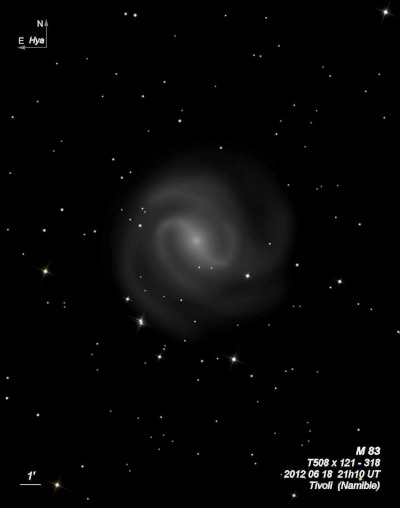
Nicolas-Louis de Lacaille discovered M83 = NGC 5236 = Lac I-6 = D 628 = h3523 in 1751-1752 with only a 1/2-inch telescope at 8x during his expedition to the Cape of Good Hope. He simply described a "small, shapeless" nebula. M83 is the only galaxy in Lacaille's list and its remarkable that it was discovered with so small an aperture. Charles Messier was barely able to view it from Paris, noting "It appears as a faint, even light, but is difficult to see with the telescope that the slightest illumination of the micrometer's crosshairs causes it to disappear. It requires considerable concentration to see at all."
William Herschel made two observations of M83: On 15 Mar 1787 (sweep 711) he logged "vB, a bright resolvable nucleus in the middle with F branches about 5' or 6' long, E sp-nf." On 5 May 1793 he logged "vB, a SBN with very extensive and vF nebulosity; it more than fills the field, it seems to be rather stronger from sp to nf. It may be ranked among the nebulous stars."
James Dunlop observed M83 on 29 Apr 1826 and recorded "185 Centauri is a very beautiful round nebula, with an exceedingly bright well-defined disk or nucleus, about 7 or 8 arcseconds diameter, surrounded by a luminous atmosphere or chevelure, about 6' diameter. The nebulous matter is rather a little brighter towards the edge of the planetary disk, but very slightly so. I can see several extremely minute points or stars in the chevelure, but I do not consider them as indications of its being resolvable, although I have no doubt it is composed of stars." His published position is off by some 12+ minutes in RA, but Glen Cozens found a copying error of exactly 13 minutes from his handwritten position. His original position is within 10' of center.
John Herschel's first observation from the Cape of Good Hope on 5 May 1834 reads "vB, vL, sbM to a centre equal to a star 9th mag, diam 8", of a resolvable character like a globular cluster, surrounded by an immensely large, extremely dilute almost equable light 7' or 8' diameter, somewhat oval, and passing with excessive suddenness into the central light."
William Lassell discovered the spiral nature using his 48-inch fork-mounted reflector on Malta in May 1862. He sketched M83 as an elegant three-branched spiral (Plate VII, Fig. 28, in Memoirs of the Royal Astronomical Society, Vol 36). The NGC description "3 branched spiral" refers to Lassell's sketch. It was also sketched by Turner as an elegant "S" shaped spiral on the unpublished Plate VI, figure 62 as well as by Pietro Baracchi in Apr 1885.
M83 has 6 known supernovae, the first (SN 1923A) found by Lampland on a photograph taken 5 May 1923 with the 40-inch Lowell reflector.
200/250mm - 8" (3/24/84): very bright, bright core, elongated, impressive.
300/350mm - 12" (6/29/02 - Bargo, Australia): this was my best view to date of M83 with a beautiful spiral structure clearly evident and multiple knotty arms. Well concentrated with a prominent core and very small nucleus. A very long, spiral arm is attached on the west side of the central core or bar but quickly bends to the north, becoming more spread out and diffuse. It continues to wind along the entire east side of the halo and fades out near a close double star, which is the middle of three collinear stars to the SE of the galaxy. Two other principal arms are visible - one is attached on the following end of the core and heads south, wrapping clockwise around the core towards the west. A third arm emerges from the core on the west side and winds clockwise towards the north. Offshoots of the main arms are difficult to trace and contribute to the general background glow of the halo.
400/500mm - 17.5" (5/10/86) : brighter arm or arc visible north of the core.
600/800mm - 24" (4/11/08 - Magellan Observatory, Australia): M83 resembled the photographic appearance in the 24" at 200x. The bright "bar" was elongated SW-NE and roughly 3'x1' in size with a well-defined bright, round core, 1' in diameter. The first prominent arm is attached at the northeast end of the bar and sweeps south (counter-clockwise) on the east side of the core, wrapping around the southeast side and spreading out a bit as it terminates to the south of the core (~3' from the center). This arm has a high contrast along its outer edge and a couple of faint stars or HII knots are visible near where it attaches to the bar. On the southwest end of the bar a second prominent inner arm emerges and abruptly wraps counter-clockwise around the galaxy on the west side as it heads north. This arm continues to wrap around the north side before spreading out on the northeast side and merging into the outer halo ~3.5' from center on the northeast edge of the halo. A third, more ill-defined arm, also emerges from the core on the south but sweeps more gently to the west (instead of heading north) on the outside of the second arm. It spreads out and fades into the general glow about 3.5' SW of center near a superimposed mag 12 star. Offshoots of the main arms are difficult to trace and contribute to the general background glow of the halo.
900/1200mm - 48" (4/7/13): During this observation of M83, I focused on the HII regions that light up portions of the remarkable spiral arms that emanate from the 3'x1' central bar. The bar is sharply concentrated with a small, intensely bright, 1' round core. At the northeast end of the bar a high contrast arm begins to sweep counterclockwise along the east side, ending up directly south of the core. Several knotty clumps were visible in the region where the arm is attached. First, at the northeast end of the central bar [1.2' NE of center] is NGC 5236:[dPD83] 42, a 10" HII knot. This designation is from a 1983 paper by de Vaucouleurs, Pence and Davoust that includes a map of the 60 brightest HII regions. Close east of this knot is #46, a 20"x10" elongated patch, situated where the arm begins to unfurl to the south [1.7' NE of center]. HII region #54 is another 12" knot a bit further southeast [0.6'] along the arm [1.9' ENE of center].
On the opposite southwest end of the bar a prominent second arm emerges and spirals out counterclockwise along the west side of the galaxy heading north and then spreading out as it curves east. The arm dims noticeably on the northeast side of the halo near a mag 13 star and has a low surface brightness as it continues south in the outer halo, heading towards h 4599, an 8" pair of mag 8.2/10.7 stars. Several knots are visible in this arm. As the arm emerges at the southwest end is #22 and #18, a small 10" knot [1.8' SW of center]. Close north is an elongated clump [2.0' WSW of center], ~25"x10", containing #13 and #15. Another elongated patch, 30"x10", containing #12 and #16, is 1' further north along the arm [1.9' WNW of center]. Additional HII regions were visible at the northern side of the arm; #39 and #43 are a close pair of small knots ~2.5' NNE of center. Further east along the arm [3.3' NE of center] is #56, another elongated patch, 20"x10".
A third, wider and more diffuse arm begins on the south side of the bar. It extends below the brighter arm on the west side, and sweeps more gradually, forming an outer western arm. This arm passes just north of a mag 12 star and ends about 4' W of center at a brighter, elongated patch that includes #2 and #3, as well as a mag 15 star.
48" (5/15/12): jaw-dropping view of M83, with the galaxy filling about 2/3 of the 375x field. I didn't take detail notes as we were looking for a recently discovered ultraluminous X-ray source (ULX), in which a companion star is orbiting a neutron star or black hole. We found a stellar or quasi-stellar object at the north edge of the central core, but this was likely a compact HII region (the ULX is ~1' E of the nucleus).
Notes by Steve Gottlieb
NGC 3242
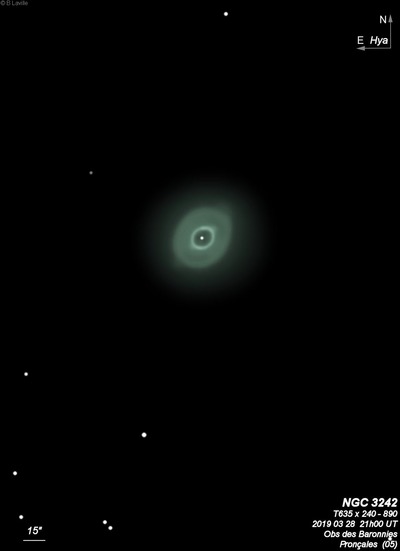
William Herschel discovered NGC 3242 = H IV-27 = h3248 on 7 Feb 1785 (sweep 368) and described this bright planetary as "a beautiful, very brilliant globe of light; a little hazy on the edges, but the haziness goes off very suddenly, so as not to exceed the 20th part of the diameter, which I suppose to be from 30 to 40" in diameter. It is round, or perhaps a very little elliptical, and all over of an uniform brightness: I suppose the intensity of its light to be equal to that of a star of the 9th magnitude." On a second observation he logged "Beautiful, brilliant, planetary disk, ill defined, but uniformly bright, the light of the colour of Jupiter. 40" diameter. Second observation, near 1' diameter by estimation." Interestingly, this is perhaps the only example where WH referred to a color in a planetary.
William Lassell observed NGC 3242 on 12 Mar 1853 with his 24-inch equatorial reflector on Malta and noted "a brilliant light blue colour with slight green tinge." The double ring structure was described at Birr Castle, as well as the northwest extension of the inner ring. On 6 Apr 1863 Samuel Hunter logged,"Outer ring is brightest north and south and fainter preceding, but vF on sf side, it does not appear so blue as the inner and brighter one....The little projection of np end of the bright ring is very marked." E.E. Barnard and Sherburne Burnham observed the planetary with the 36-inch at Lick Observatory on 25 Feb 1889. Barnard described in his logbook "a glowing star in center of dark space, this in in parallelogram or diamond shape () of beautiful bluish green. This in an elliptical rose colored disc."
Admiral Smyth noted the planetary "resembles Jupiter" in his "Cycle of Celestial Objects" (1844), following Herschel’s comment. But the nickname "Ghost of Jupiter" was apparently first used by Captain William Noble. In the 1882 issue of Knowledge, he wrote "It will be a seen as a pale-blue disc, looking just like the ghost of Jupiter." He repeated this description in "Hours with a Three-Inch Telescope" (London and New York, 1886). William Tyler Olcott also stated "It will be seen like a pale blue disk, like a ghost of jupiter" in his 1909 book "In Starland with a Three-Inch telescope”.
Based on Crossley photographs at Lick, Curtis (1918) reported "the inner, roughly elliptical ring with its slightly fainter extensions is about 26"x16" in pa 145°. The outer and considerably fainter oval disk is 40"x35", and shows faint ring or shell effects at its edges.
300/350mm - 13.1" (3/24/84): very bright, bright inner lens surrounded by a second fainter elliptical shell. At 350x there is a darker center to the inner lens and the central star is visible almost continuously.
400/500mm - 17.5" (3/25/00): this beautiful PN has a very high surface brightness and a bluish color at 100x. The view at 280x-380x is stunning with a well-defined double shell structure. The bright, narrow inner ring is surrounded by a second fainter oval envelope. Inside the bright lens is a dark, 10" donut-hole with a faint central star marking the center. In moments of steady seeing, the inner ring has a hard-edge and the central star is easier.
17.5" (1/31/87): at 415x appears very bright, fairly small, bluish color, central star is visible. Prominent double lens structure with a bright inner lens surrounded by a second fainter elliptical shell. Stunning at high power with a striking "eye" appearance with a darker center.
900/1200mm - 48" (4/18/15 and 5/1/19): In addition to the structure previously noted, the sharply defined inner ring clearly has lower surface brightness extensions at the northwest and southeast end, creating an inner lens. The bulge on the northwest end is a bit larger and brighter, though the southeast end of the ring has a slightly brighter knot.
Two galaxies are nearby. PGC 155202, 3.9' SSW of NGC 3242, is fairly faint, fairly small, slightly elongated NNW-SSE, 20"x15", very weak concentration. A mag 11.2 star lies 1.9' NE. PGC 155215, 3.4' SE of NGC 3242, is faint, small, slightly elongated WNW-ESE, 15"x12", low surface brightness. A mag 14 star lies 0.6' WNW and a mag 10 star is 2' E.
48" (2/18/12): at 814x, the multiple ring structure was remarkable. The small, dark central hole and bright central star was surrounded by a beautiful inner lens, elongated 3:2 NW-SE, ~25"x15". This vivid turquoise lens was brighter at the ends of the major axis and bulges out with an extension on the northwest end. Surrounding the lens was a broader halo or shell with a rounder outline, ~45"x35" NW-SE. This shell had a distinctive light pink or salmon color. Highlighting the very edge of this shell is an extremely thin, slightly brighter greenish ring. A low surface brightness outer halo surrounds the planetary.
48" (4/1/11): stunning view at 488x with a high contrast, high surface brightness double ring structure and an outer third shell. The small inner lens has an electric turquoise color and is elongated 3:2 NW-SE, ~25"x15". At the southeast end of the major axis of the inner ring is a well-defined, bright knot. The irregular inner ring is also brighter and thicker along the northwest end, though not as bright or sharply defined as the southeast knot. The dim central portion is punctuated by the bright central star. The outer ring is rounder and extends ~45"x35" NW-SE, with the limb unevenly lit. The greenish color is not as intense in the outer ring. Between the two main rings the nebulosity has a pinkish hue. The main structure was surrounded by a low surface brightness outer halo, at least 1.5' diameter, which significantly increased the total size!
Notes by Steve Gottlieb
M 48
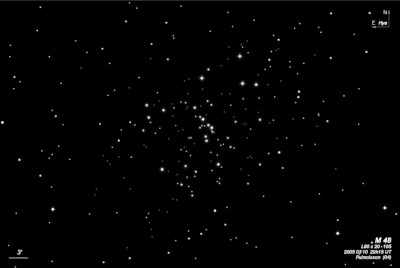
Charles Messier discovered M48 = NGC 2548 = H VI-22 = h496 on 19 Feb 1771 and described a "Cluster of very faint stars, without nebulosity; this cluster is a short distance from the three stars that form the beginning of the Unicorn's tail." Johann Bode independently found it the cluster again before 1782. But the identification of M48 was lost due to an error in Messier's listed position. In a 1934 book, Oswald Thomas identified M48 with NGC 2548 (without explanation) and in 1959 T.F. Morris pointed out that NGC 2548 has the same RA as Messier's position for M48 though differed by 5° in declination. Owen Gingerich publicized Morris' identification in his 1960 article "The Missing Messier Objects" in Sky & Tel.
Caroline Herschel independently discovered M48 on 8 Mar 1783 and William found it on 1 Feb 1786 (sweep 519). He recorded VI-22 (later NGC 2548) as "a beautiful cluster of stars, considerably rich, and pretty much compressed, 10 or 12' dia. The stars are nearly of a size, white and pretty large." He later noted "C.H. [Caroline Herschel] discovered it in 1783."
300/350mm - 13.1" (2/16/85): about 125 stars in a large 40' field with no distinct borders. A rich chain of stars oriented SSW-NNE passes through the center. Includes a number of brighter mag 10 stars and many double stars. Partially resolved in 16x80 finder.
400/500mm - 18" (3/15/10): large, sprawling cluster that nearly fills the 67' field of the 31mm Nagler. The most distinctive portion, though, is a 20'x15' group near the center which contains roughly 75 stars, many arranged in strings. Most prominent is a fairly dense SW-NE string of brighter stars that cuts through the cluster with a nice double star in the center (h 2435 = 9.6/9.7 at 7"). A short chain of a few stars branches off to the south of h2435. Another stream of stars branches off this string to the SSW. A third elongated group of stars extends SW-NE on the south side, roughly parallel to main string, and is separated by a mostly starless lane. The cluster includes a number of mag 8-9 stars, with the brightest mag 8.2. At 73x, the main cluster is wedged between two very long streams of stars, roughly oriented NW to SE off both the north and south sides of the main group. These two strings of stars extend the total diameter to over 50'. On the NW side of the central group, a number of stars are scattered between these two streams including a few very wide pairs, but the SE end the two streams are well separated with a very few stars in between.
Notes by Steve Gottlieb
M 68
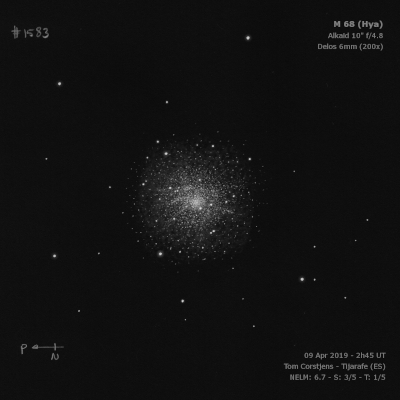
Charles Messier discovered M68 = NGC 4590 = h3404 on 9 Apr 1780. WH described "a beautiful cluster of stars, extremely rich, and so compressed that most of the stars are blended together; it is near 3' broad and about 4' long, but chiefly round, and there are very few scattered stars about." In his 1814 publication he noted "this oval cluster is also approaching to the globular form, and the central compression is carried to a high degree." JH made the single observation "GC; irr R; gbM; diam in RA = 12...15 sec. All clearly resolved into stars 12 m; very loose and ragged at the borders."
200/250mm - 8" (3/24/84): few stars resolved across disk.
300/350mm - 13.1" (3/24/84): about 20 stars resolved around edges of core and in halo. The core is mottled but unresolved.
400/500mm - 17.5" (2/28/87): 30-50 stars resolved including many fairly bright stars over unresolved background haze.
600/800mm - 24" (5/22/17): at 375x; very bright, well resolved globular with quite a number of surprisingly bright stars [brightest stars Vtip = 12.6] spread over the central region and around the edges, giving a fairly loose appearance [class X]. The unresolved central background glow is large and bright. Perhaps 60-75 stars are resolved in the central region, but excluding the outer portion of the halo, which also seems to contain a number of brighter stars out to at least 8'.
Notes by Steve Gottlieb
NGC 3621
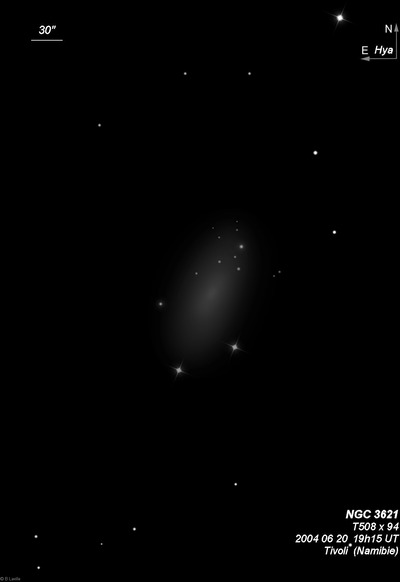
William Herschel discovered NGC 3621 = H I-241 = D 617 = h3337 on 17 Feb 1790 (sweep 808) and recorded "cB, vgbM, E from about 70° np to sf, about 6 or 7' long and near 4' broad. Within a parallelogram of stars." This is the most southerly object he discovered! From the latitude of Slough, NGC 3621 culminated at an elevation of only 6.8°!
James Dunlop observed NGC 3621 on 7 May 1826 with his 9-inch reflector from Parramatta, NSZ, and recorded "a very faint pretty large nebula, about 2' broad and 4' long, very faint at the edges. The brightest and most condensed part is near the south following extremity; a small star is involved in the north preceding extremity, and there are two small stars near the south extremity, but not involved." Dunlop made two observations and his published position is 10' NE of center.
John Herschel observed the galaxy on 29 Apr 1834 from the Cape of Good Hope and recorded, "pB, vL, oval, vgvlbM, resolvable [mottled], 5' long, 3' broad."
400/500mm - 17.5" (4/6/91): bright, large, elongated 5:2 NNW-SSE, 6' diameter, weak central concentration and along the major axis but no sharp nucleus. Several stars are nearby; three mag 11-13 stars are off the north tip and two mag 10 stars are 2.7' SW and 3.7' SSE of center.
900/1200mm - 48" (5/9/18): at 488x; this prominent galaxy is extremely large, irregular but elongated at least 2:1 NNW-SSE. The main disk extends ~7'x3' and is noticeably mottled and dappled with slightly brighter and darker areas. Around the periphery is a a very low surface brightness outer halo that dissolved into the background sky, but could be traced ~5' SE of center. The galaxy contains a very large, brighter central region, which appeared somewhat offset within the main disk, though it was less defined than a typical core or nucleus. The most noticeable features are a couple of large dust lanes that border or outline spiral arms and arcs. A long, thin dust lane extends in a SSE to NNW orientation, just east of the central region. This dark lane cuts off or borders a relatively narrow spiral arm that is adjacent to the east. It contains a brighter 10" knot (stellar association/HII complex [KWB2013] 104), that was easily visible 1.1' ESE of center and 1.1' due west of mag 12.7 star. A broader dusty lane extends SSE to NNW along the west side. A very low surface brightness arm running parallel is just west of this darker lane or gap. The galaxy is outlined by several brighter stars; two mag 10.3/10.6 stars are near the southern edge of the halo, 2.8' SSW of center and 3.9' SSE of center, and a mag 12.7 star is placed ~2.5' ESE of center. A number of stars cradle the north end of the galaxy; the brightest is a mag 11.6 star [2.6 NW of center], which forms a kite asterism outlining the galaxy, along with the previous three stars. In additional a couple of stars are superimposed on the north side of the main glow and a number of additional mag 13 and 14 stars are at the northern edge of the halo.
Notes by Steve Gottlieb
NGC 3109
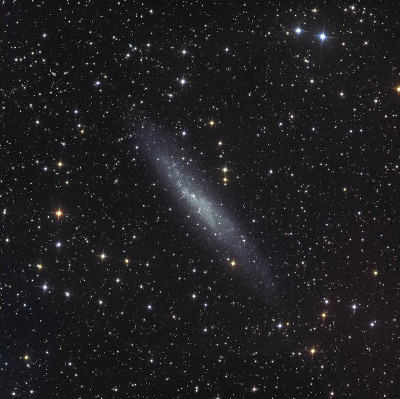
John Herschel discovered NGC 3109 = h3221 on 26 Mar 1835 and recorded "vF; vL; 12' l; 2' br; lbM; pos of axis 82.3°. See pl. V. fig 9." His position and description and sketch (Plate V, figure 9) matches this large edge-on.
Joseph Turner sketch NGC 3109 in Feb 1876 with the Great Melbourne Telescope, though his sketch shows the galaxy extending between the four stars off the north edge (which are not involved). A lithograph based on the sketch was never published. While searching for NGC 3109 on 9 Apr 1885 with the GMT, Pietro Baracchi discovered nearby ESO 499-023.
Although Sidney van den Bergh concluded in his 2000 book "The Galaxies of the Local Group" that NGC 3109 was just outside the Local Group, bur recent papers assume this galaxy (along with Sextans A, Sextans B and the Antlia dwarf) is at a distance of 4.2-4.4 million light, on the outskirts of the Local Group.
400/500mm - 17.5" (2/28/87): fairly faint, very large, very elongated 4:1 E-W, diffuse. Appears as a low surface brightness streak with very weak concentration.
900/1200mm - 48" (5/4/16): fairly bright, very large, very elongated 6:1 E-W, ~15'x2.5'. Contains a large brighter irregular core region but no nucleus. A mag 12.5 star is superimposed near the center and a number of fainter stars are superimposed. Overall the surface brightness is fairly low but patchy with several very small knots.
Near the southwest edge of the galaxy, 3.9' WSW of the mag 12.5 star, is a faint 12" knot, identified in SIMBAD as [BCP93] F3 H2 from the 1993 paper "The dwarf galaxy NGC 3109. I - The data". A faint 10" knot, listed as [BCP93] F1 H3, is 1.1' NW of the same star and another quasi-stellar knot (perhaps a faint star) is close northwest of the star. Finally, on the southeast flank of the galaxy is a faint larger patch, perhaps 15"-20", catalogued as [BCP93] F5 H1.
Notes by Steve Gottlieb
NGC 5694
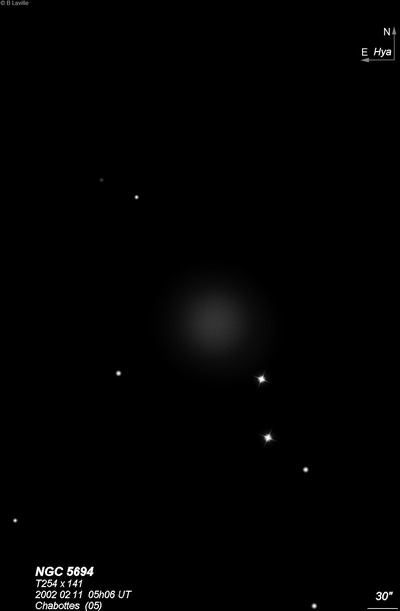
William Herschel discovered NGC 5694 = H II-196 = h3576 on 22 May 1784 (sweep 223) and recorded "pB, S, r, nearly R and bM. It forms an arch, or very bright obtuse triangle with two stars very near and preceding it. The arch is concave to the northeast and the two stars with the nebula are all within 5'." John Herschel called the cluster "vB; pL; R; psbM; 1st class; 20"; r; several stars near." His RA in the Cape Catalogue was 35 seconds too large. Heinrich d'Arrest (who noticed the error) and Engelhardt measured accurate micrometric positions.
Announced as a globular cluster in the 1934 paper "Object NGC 5694 a Distant Globular Star Cluster" by Lampland and Clyde Tombaugh (1932AN....246..171L) at Lowell Observatory, based on photographic plates taken with the 13" Lowell telescope and followed up with the 42-inch reflector. The large reflector clearly showed this was a condensed globular cluster.
200/250mm - 8" (6/27/81): fairly faint, small, bright core.
400/500mm - 17.5" (4/13/96): moderately bright but compact globular of 2' diameter with a round, symmetrical appearance. Contains a 40" well defined core that increases to a nearly stellar nucleus. There is no evident resolution in the halo. Situated at the end of a string of brighter stars with two mag 11 stars close SSW.
17.5" (5/10/86): this is a small globular cluster with a very small bright core and a fainter outer halo. Very mottled and grainy but no resolution. A pair of mag 11 stars oriented N-S are off the SW side about 1.5' and 2.5' from the center.
Notes by Steve Gottlieb
NGC 2784
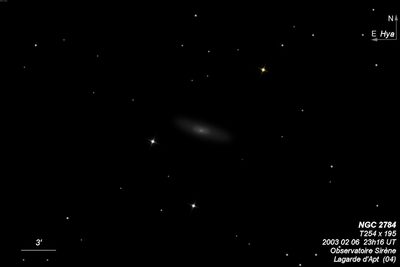
William Herschel discovered NGC 2784 = H I-59 = h571 = h3148 on 20 Nov 1784 (sweep 326) and noted, "S, cBM but vF at the side, a very little E; the chevelure of the milky kind." On 7 Jan 1831 (sweep 317), John Herschel noted, "pB; R; gbM; 25"." On 23 Jan 1835 (sweep 532) at the Cape of Good Hope, he called it "B, L, mE, pgmbM, 4' l, 90" br, position = 63.7°."
400/500mm - 17.5" (2/28/87): very bright, moderately large, very bright core with much fainter extensions, elongated 2:1 WSW-ENE, possibly a sharper edge along the north side. A mag 10.5 star is 3.7' E of center.
Notes by Steve Gottlieb
NGC 2835
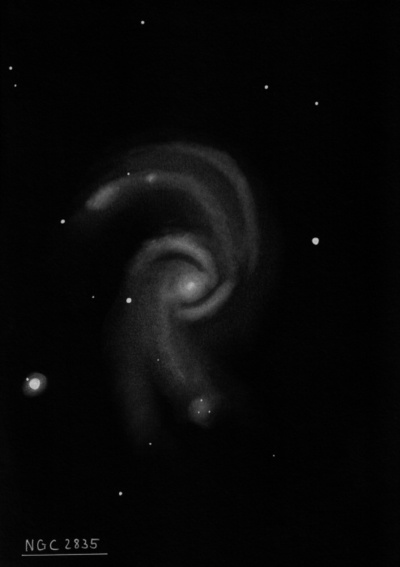
Wilhelm Tempel discovered NGC 2835 on 13 Apr 1884. E.E. Barnard made an independent discovery in early 1885 while comet-seeking with his 5-inch refractor. In The Observatory 8, p123, he wrote "very faint, close between two bright stars, the n.p. of which is about 8 mag, the s.f. is about 9 mag. A 10th mag star is involved in the following edge of the nebula." His position (determined with the 6-inch equatorial) was accurate. After the discovery was announced in The Observatory, Wilhelm Tempel claimed an earlier discovery on 13 Apr 1884 in a note to his "New Nebulae" in AN 2660. Barnard was credited with the discovery in the NGC, as Dreyer apparently missed Tempel's comment.
Based on photographs taken with the Reynolds reflectors at the Helwan Observatory in 1919-20, NGC 2835 was described as "pF, 7'x4', E10°; beautiful 4-branched spiral with faint almost stellar nucleus and many almost stellar condensations along the arms."
400/500mm - 17.5" (2/28/87): very large, low surface brightness, slightly elongated, weak concentration. Bracketed by two mag 10 stars 2.8' W and 3.4' SE of center. Brightest in a small group (LGG 172), which includes NGC 2784, located 2.2° to the southwest.
Notes by Steve Gottlieb
NGC 4105
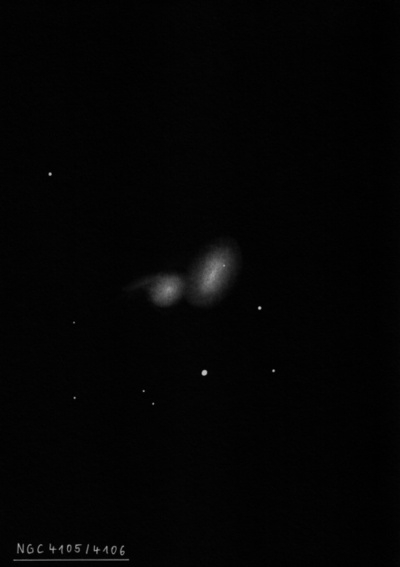
William Herschel discovered NGC 4105 = H II-865 = h3378, along with NGC 4106, on 7 Mar 1791 (sweep 998) and logged "Two, within a minute of two of each other. Both F, S, R, bM. Nearly in the same parallel." John Herschel made two observations, recording on 10 May 1834 (sweep 452), "The first of a double nebula (pos 111.2° by means of 2 measures), B; R; pL; psbM; r; 25"."
200/250mm - 8" (5/21/82): elongated glow resolves into NGC 4105 and NGC 4106 just following. NGC 4105 is slightly brighter and larger but appears faint, small and round.
400/500mm - 18" (5/28/06): western member of a close, moderately bright pair with NGC 4106, just 1.1' between centers. Appears round, ~45" diameter, sharply concentrated with a bright, prominent core. The halo is fairly faint and increases in size with averted vision to ~1' diameter. This galaxy is slightly larger and the brighter of the duo. Nearby galaxies include IC 2996 lies 17' SW, IC 3005 17' SE and IC 3010 38' SE.
Notes by Steve Gottlieb
NGC 5101
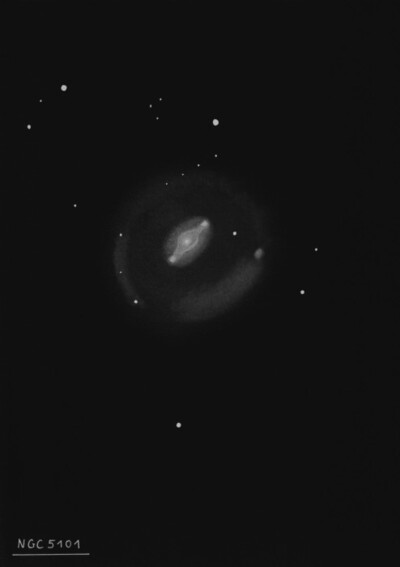
William Herschel discovered NGC 5101 = H II-567 = h3493 on 28 Mar 1786 (sweep 550) and recorded "pB, pL, gbM; iF." His position is 46 tsec preceding ESO 508-058. JH made two observations from the CGH and measured an accurate position.
200/250mm - 8" (5/21/82): fairly faint, small, elongated NW-SE. A mag 12 star is close W.
300/350mm - 13.1" (3/17/86): moderately bright, elongated WNW-ESE, gradually increases to a small bright core. A mag 12.5 star is 1.6' W of center. NGC 5078 lies 27' W.
Notes by Steve Gottlieb
NGC 5078
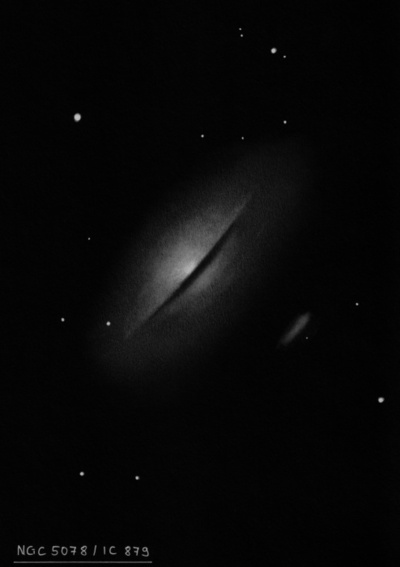
William Herschel discovered NGC 5078 = H II-566 = h3484 on 28 Mar 1786 (sweep 550) and recorded "F, pS, E." His position is accurate. From the Cape of Good Hope, JH logged "pB, S, pmE, psbM; has a star 7-8th mag following." Both Herschels missed nearby IC 879.
300/350mm - 13.1" (3/17/86): moderately bright, very elongated 3:1 NNW-SSE, bright core. This pretty system is located 10' W of mag 7.7 SAO 181564. NGC 5101 lies 27' E. Forms a close pair with IC 879 2.5' WSW (not seen).
600/800mm - 24" (5/25/14): at 282x, appeared bright, fairly large, elongated 5:2 NNW-SSE, 2.0'x0.8', sharp concentration with a bright, thin elongated core that looks like a bar. Although the equatorial dust lane immediately southwest of the bar was not noticed at a low elevation, the galaxy was brighter and more extensive on the following side of the bar. Forms a pair with IC 879 2.5' SW. Mag 7.8 HD 115890 lies 9' E. Also nearby are IC 874 17' SW and NGC 5101 25' E. The Arp-Madore atlas describes NGC 5078 as an "edge-on Sa with interacting companion IC 879] + dust." IC 879 appeared fairly faint, elongated 2:1 NW-SE, 50"x25", slightly brighter 20" core, fairly low surface brightness.
Notes by Steve Gottlieb
NGC 2935
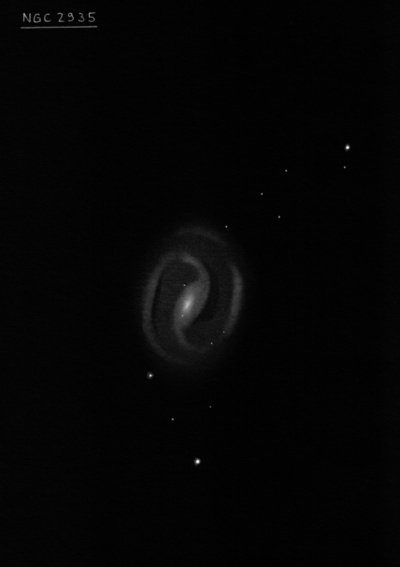
William Herschel discovered NGC 2935 = H II-556 = h3178 on 20 Mar 1786 (sweep 542) and logged "pB; cL; iR; vgbM." On 24 Dec 1786 (sweep 663) he noted "pB; vS; R; mbM." JH made two observations, recording on sweep 561: "pB; vS; gmbM; lE; 25" l, 20" br."
400/500mm - 17.5" (2/28/87): moderately bright, fairly small, elongated NW-SE, high surface brightness. A couple of mag 14 stars are superimposed and a mag 12.5 star is just off the SE end 2.1' from center. Appears brighter at the SW end. NGC 2921 lies 33' NW.
Notes by Steve Gottlieb
NGC 3673
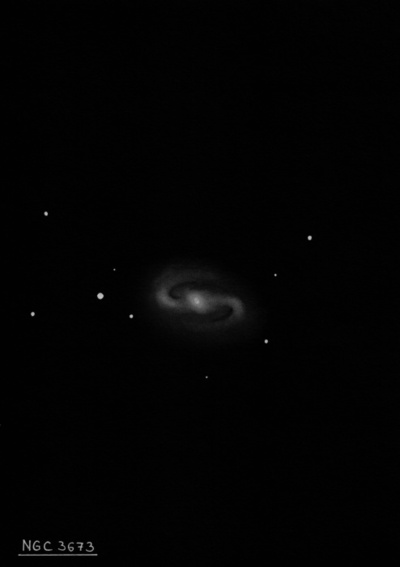
John Herschel discovered NGC 3673 = h3341 on 22 Mar 1836 and recorded "F; vL; vglbM. Several small stars near, and one = 7m nearly south, at 6' distance. HIs position and description matches ESO 503-016.
400/500mm - 18" (3/19/04): moderately bright, moderately large, elongated 3:2 ~E-W, 2.0'x1.4', broad concentration to halo. Appears brighter along the major axis like a bar (verified on the DSS) with a very small brighter core. Two mag 11.5 and 13 stars following closely, 2' and 1.5' from the center. Located 8' N of mag 8.7 SAO 179863.
18" (3/19/04): moderately bright, fairly large, elongated nearly 2:1 WSW-ENE. Contains a bright 45" elongated core embedded in a much faint halo, ~2.5'x1.5'. Within the halo is the strong impression of a bar and the galaxy is locally brighter immediately following the bar.
Notes by Steve Gottlieb
NGC 5328
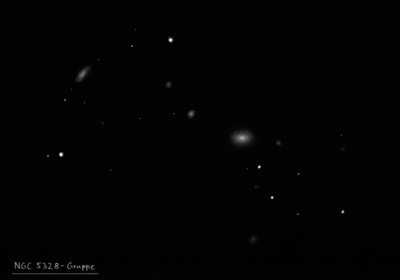
William Herschel discovered NGC 5328 = H III-923 = h3543 on 5 May 1793 (sweep 1041) and recorded "vF; vS; R; lbM. 300 shewed it very well" JH made two observations from the Cape of Good Hope: "pB; R; lbM; 20" and "B; lE; sbM; 20". Lewis Swift discovered nearby NGC 5330.
300/350mm - 13.1" (5/26/84): fairly bright, small, slightly elongated ~E-W, small bright nucleus. Located 19' WNW of mag 6 SAO 182065.
600/800mm - 24" (6/1/13): at 225x appeared bright, fairly small, oval 3:2 E-W, 30"x20", sharply concentrated with a very bright, very small nucleus. Brightest in a small cluster (Klemola 28) of early-type galaxies with NGC 5330 1.7' NE. Several of the galaxies are aligned in a NE to SW chain including PGC 3094715 2.8' NE and ESO 445-70 6.0' NE. PGC 3094715 appeared faint, very small, round, 12" diameter.
Notes by Steve Gottlieb
NGC 2889
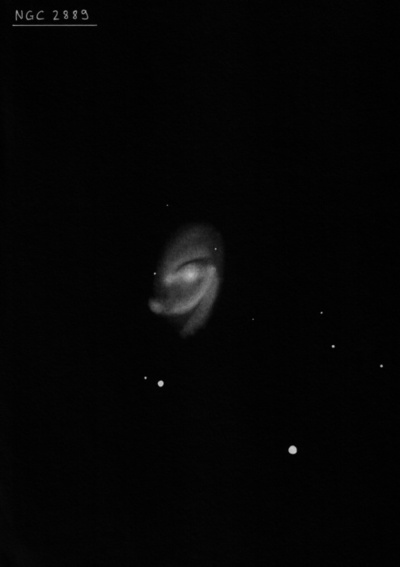
William Herschel discovered NGC 2889 = H II-555 = h600 on 19 Mar 1786 (sweep 541) and recorded "vF; pL; R; bM." On 9 Mar 1828 (sweep 129), John Herschel logged, "pB; pL; R; vglbM; 80"." Using the 72" on 30 Jan 1856, R.J. Mitchell mentioned a very faint star at the east edge and "darkness all round the nucleus."
300/350mm - 13.1" (4/10/86): fairly small, slightly elongated ~N-S, diffuse halo, irregular bright core. A mag 11.5 star is off the south edge 1.4' from the center. NGC 2884 lies 13' WNW and NGC 2881 is 28' SW.
Notes by Steve Gottlieb
NGC 2708
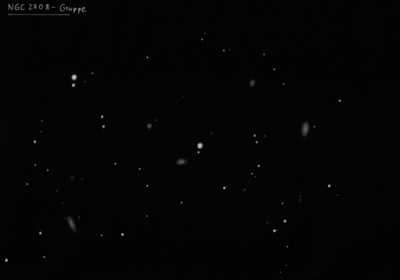
400/500mm - 17.5" (2/13/88): moderately bright, moderately large, very elongated 3:1 SSW-NNE, bright core. A mag 13.5 star is 0.9' NE of center. Forms a pair with NGC 2709 7.1' NNE. One of the brightest galaxies in a group (LGG 164) that includes NGC 2695, 2699 and 2706. Other members may include NGC 2697, 2698 and 2709.
Notes by Steve Gottlieb
NGC 3081
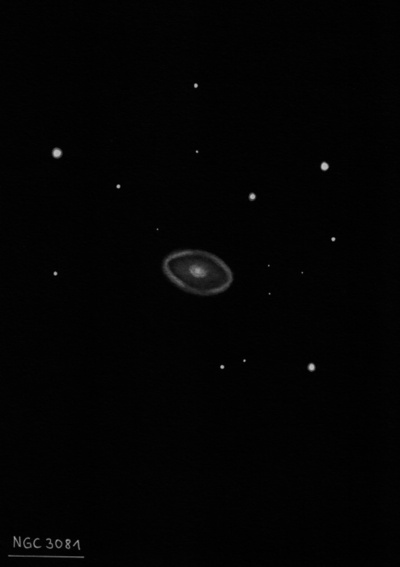
400/500mm - 17.5" (3/28/87): moderately bright, fairly small, very bright compact core, possible stellar nucleus. The fainter oval halo is extended E-W.
900/1200mm - 48" (4/18/15): this beautiful resonant ring galaxy was viewed at 488x and 610x. It was very sharply concentrated with a very bright, roundish core (slightly oval at 610x) core that gradually increased to a stellar nucleus. The surface brightness dropped significantly in the inner halo, but then brightened at the edge to a well defined oval ring, extending 5:3 WSW-ENE, 1.3'x0.8'. The ring was fairly narrow and brightened slightly at the ends of the major axis (southwest and northeast ends). This was a very distinctive object! The core itself contains a barred spiral ring, but this feature was not seen.
48" (5/3/19): at 488x; NGC 3081 is one of the most distinctive resonant ring galaxies; it was sharply concentrated with an extremely bright core that appeared roundish, moderately large, gradually intensified further towards the center. The slightly elongated elongated halo displayed a noticeable edge brightening forming a fairly low contrast ring.
Notes by Steve Gottlieb
NGC 2992
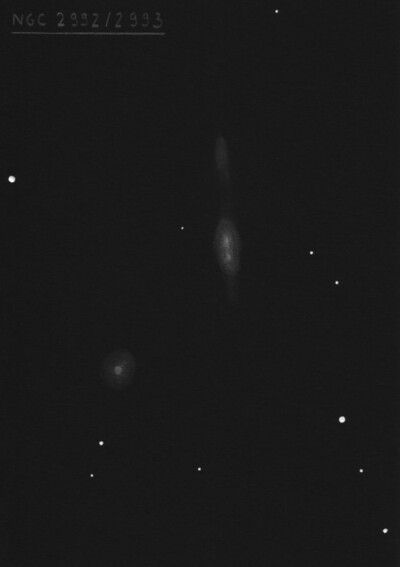
William Herschel discovered NGC 2992 = H III-277 = h635 on 8 Feb 1785 (sweep 371) and recorded "Two [along with NGC 2993], vF, stellar, the most north and preceding [NGC 2992] is the largest. 240x showed the same. Distance 3 or 4'. The place is that of the preceding." His position was ~45 seconds of RA too large (perhaps only recorded to the nearest min). John Herschel measured an accurate position on 16 Dec 1827 (sweep 111) and noted "Not vF; R; bM; 30"." Bindon Stoney noted a mottled appearance with LdR's 72" in 1852.
300/350mm - 13.1" (3/24/84): moderately bright, small, slightly elongated SSW-NNE, bright core. Forms an interacting pair with NGC 2993 2.9' SE.
13.1" (3/3/84): fairly faint, small, roundish, small brighter core.
900/1200mm - 48" (2/19/12): this disrupted galaxy is sharply concentrated with a very bright central region that is elongated ~5:2 SSW-NNE, ~1.0'x0.4'. The central region is well concentrated with an intense core that brightens to a brilliant nucleus.
I initially noted a faint arm extending 30" SSW of the central region but on a second eyepiece look I noticed this arm is twice that length, though the surface brightness is quite low in the outer portion. A long, brighter tidal arm stretches 2' NNE, placing the central region off-center along the 3.5' major axis. This arm or tail has a low surface brightness though brightens in a patch at the NNE end (2.2' NNE of center). A 2000 multi-wavelength study in AJ,120, 1238 concludes this patch (identified as Arp 245N in NED) is a tidal dwarf galaxy still in the process of formation. The western edge of the arm has a subtle curvature. With averted vision, extremely low surface brightness haze forms a bridge extending southeast from the core of NGC 2992 towards NGC 2993 (3' between centers).
Notes by Steve Gottlieb
NGC 3393
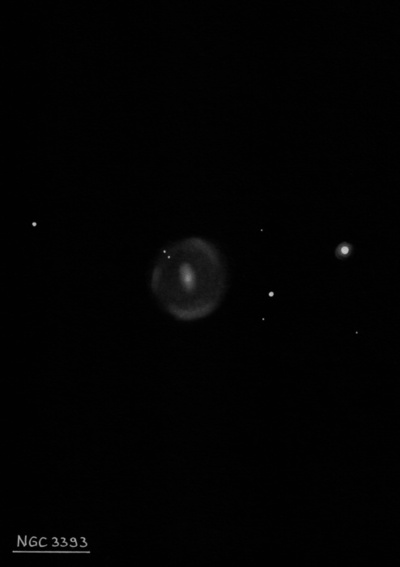
John Herschel discovered NGC 3393 = h3299 on 24 Mar 1835 and recorded "F; S; R; precedes two bright stars." His position (3 sweeps) matches ESO 501-100.
400/500mm - 18" (3/13/04): faint, fairly small, elongated 2:1 NNW-SSE, 0.8'x0.4'. Contains a small, round, bright nucleus. The galaxy precedes two mag 9 (HD 93674) and 11 stars 2.9' E and 1.6' E (nearly equally spaced with galaxy). This observation (made through thin clouds) refers to the brighter core region and I probably missed the large, low surface brightness halo. Outlying member of AGC 1060 (Hydra I), located 3.5 degrees northeast of the core.
Notes by Steve Gottlieb
NGC 5152
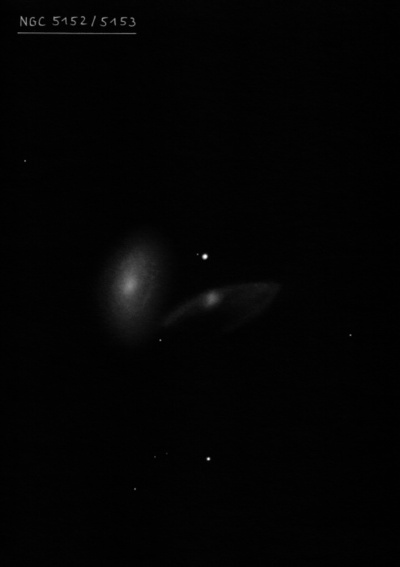
John Herschel discovered NGC 5152 = h3508 on 5 May 1834 and recorded "The preceding of a double nebulae; the individuals are = ; R; vF; S; pslbM."
The pair was nicknamed the "Fly's Wing" in the 1982 "Catalogue of the Universe" by Murdin and Allen. Bill Keel also called it the "Flywing" in "The real astrophysical zoo - Colliding galaxies" in the April '93 issue of Mercury magazine. Still, a Google search doesn't find any hits for this nickname.
300/350mm - 13.1" (5/26/84): appears as stellar galaxy 0.9' W of NGC 5153 and 5' SE of NGC 5150.
Notes by Steve Gottlieb
NGC 2610
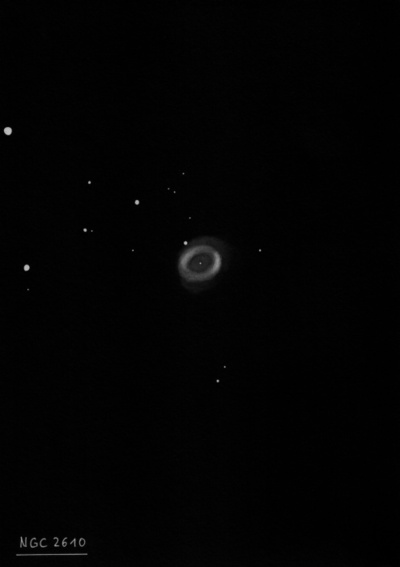
William Herschel discovered NGC 2610 = H IV-35 = h513 = 3127 on 31 Dec 1785 (sweep 503) and recorded "a small star with an electrical brush sp; F; S. About 1 1/2' after follows a star of the 8th magnitude. It resembles fig 7, Phil. Trans. Vol LXXIV.Tab.17. [Plate VII]". Herschel commented in his 1814 PT paper that "a small star has a small, faint, fan-shaped nebulosity joining to it on the north preceding side." He used this example to (incorrectly) demonstrate the union or mutual attraction between the objects. On 16 Nov 1827 (sweep 111), John Herschel wrote, "A * 14m with a fan-shaped brush 15" l to the sp side; the brush however judged by both Mr. [James?] Dunlop (who saw it) and myself not to be in contact." The 1 Feb 1851 observation by Lord Rosse reads "Dark space foll star, bet neb and star stronlgly suspected like the "snow-drop nebula" [NGC 2261]. Lord Rosse suspected a star in it also."
In 1915, Harold Knox-Shaw reported this object was annular and the spectrum probably gaseous based on a photograph with the Reynolds reflector at the Helwan Observatory. The spectrum was confirmed by Campbell and Paddock at Lick. Based on Crossley photographs at Lick, Curtis (1918) reported "the ring is slightly irregular, hazy and without structural detail; is 38"x31" in pa 75°. Relatively vacant around the central. The matter in the ring is rather faint."
300/350mm - 13.1" (1/18/85): moderately bright PN, fairly small, slightly elongated ~N-S, about 40" diameter. No annularity or central star seen. A mag 13 star is at the NE edge. Located 3.5' SW of mag 6.6 SAO 154395.
400/500mm - 17.5" (3/25/00): at 280x using a UHC filter appears moderately bright, ~45"x40", elongated SSW-NNE. A mag 12 star is embedded on the NE edge of the rim. The planetary appears to taper near the star although this may be a contrast effect. The rim is sharp-edged and the surface brightness pretty smooth. Located 3.5' SW of a mag 6.5 star.
900/1200mm - 48" (2/28/19 and 3/1/19): at 488x and 813x; bright, fairly large, roundish, 50" diameter. Contains a thick brighter rim (about half the diameter) with a darker central hole. The rim is slightly brighter in a 90° arc centered on the NW side and appears slightly irregular or ragged around the periphery. The rim was slightly weaker just south of a prominent 12th magnitude star on the NE edge. The faint central star was easily visible. With a NPB filter there was a thin outer halo. Located 3.5' SW of a mag 6.6 HD 72665.
Notes by Steve Gottlieb
NGC 2936
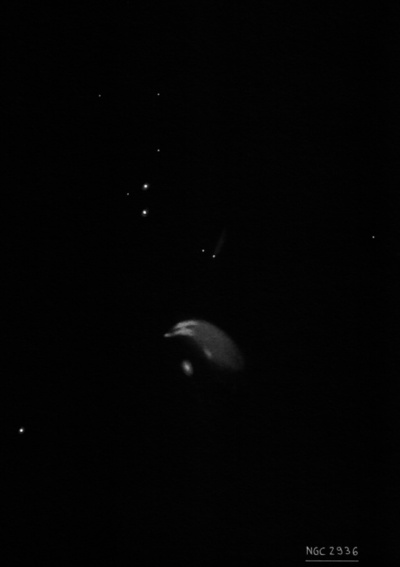
Albert Marth discovered NGC 2936 = m 175 on 3 Mar 1864, along with NGC 2927, and simply noted "vF, iR." His position is 1' S of UGC 5130. The dimensions of NGC 2936 and 2937 appear reversed in the RC3 and MCG.
400/500mm - 17.5" (3/25/95): fairly faint, fairly small, elongated 4:3 E-W, 0.8'x0.6'. A mag 13/14 double star at 18" separation is 1' NNW and two mag 13.5/14 stars at 36" separation are 2' NNE. Forms a very close pair with NGC 2937 0.8' S.
900/1200mm - 48" (2/20/12): bright disrupted galaxy with a highly irregular surface brightness and a curving shape with a faint tail. At 375x and 488x, the central region is extended E-W, roughly 30"x20", with a very small bright nucleus. A low surface brightness "tail" is attached on the west side of the bright central region. The relatively broad tail sweeps south-southwest for ~45", gradually dimming out due west of the center of NGC 2937. The tail significantly increases the overall dimensions of the galaxy to at least 1.2'x0.6'.
Forms a close pair with NGC 2937 to the south with the cores of the galaxies separated by less than 1'. A mag 13 star is 1' NW and just beyond is LEDA 1237172, a very low surface brightness streak extending ~18"x5" NW-SE. Arp describes LEDA 1237172 as a "shred" or "jet" of NGC 2936.
Notes by Steve Gottlieb
NGC 3314
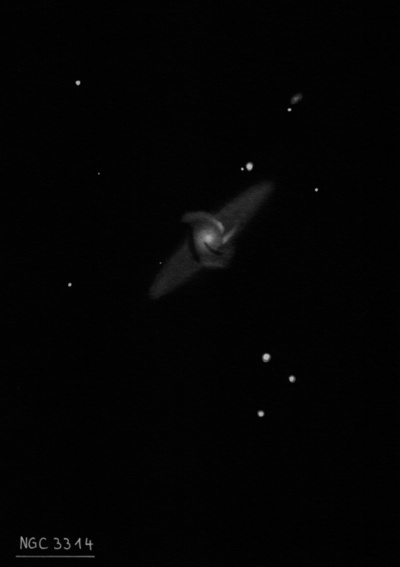
John Herschel discovered NGC 3314 = h3283 on 24 Mar 1835 and simply noted "the 8th of a group." His position is an exact match with ESO 501-IG046A/B. Pietro Baracchi recorded this object as "pF; S; R; gbM. A star 14m close n.p. Also a star 16m also np." (10 Mar 1886, GMT)
NGC 3314 consists of a face-on galaxy (NGC 3314B) superimposed on an edge-on galaxy. The HST has a remarkable image showing the dust within the foreground galaxy visible because it is silhouetted against the light from the object behind it.
300/350mm - 13.1" (2/18/04 - Costa Rica): moderately bright, moderately large, spindle-shaped, very elongated 3:1 NW-SE, 1.5'x0.5'. A mag 13 star is at the NW tip. Located 7' ESE of a mag 6.7 star which detracts from viewing. Similar to NGC 3312 in the core of AGC 1060, but slightly smaller.
13.1" (2/23/85): fifth of five in the core of AGC 1060. Fairly faint, small, elongated ~NW-SE. Located 6.8' ESE of mag 6.8 SAO 179027. NGC 3312 lies 7.6' NNW.
600/800mm - 24" (3/28/17): moderately bright, moderately large, very elongated 3:1 or 4:1 NW-SE, 1.3'x0.35' spindle. Modest concentration with a slightly brighter bulging central region. A mag 13.5 star is situated at the northwest tip [36" from center].
900/1200mm - 48" (4/21/17): at 488x; fairly bright, moderately large, very elongated 4:1 NW-SE, 1.5'x0.4', brighter core. Roughly spindle shaped but tapers more on the northwest end. Irregular surface brightness (slightly brighter along the south side), but the foreground galaxy could not be distinguished. A mag 13.5 star is just north of the NW tip.
Notes by Steve Gottlieb
UGC 4349
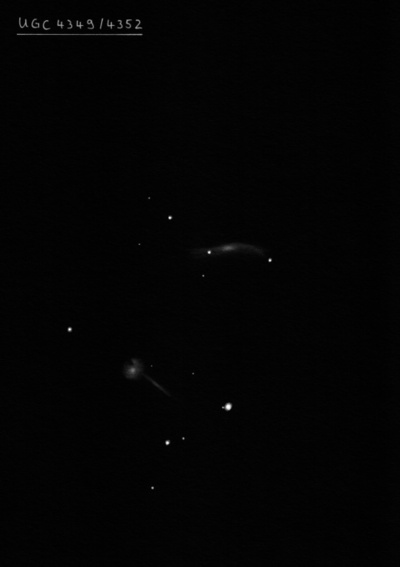
600/800mm - 24" (3/9/13): this challenging edge-on appeared as a very faint "spike" extending west of a mag 13 star, ~20"x6". Located 2.9' N of a mag 9.5 star. First in the KTG 21 triplet with UGC 4352 (double system) 2.9' SE.
Notes by Steve Gottlieb
NGC 3280
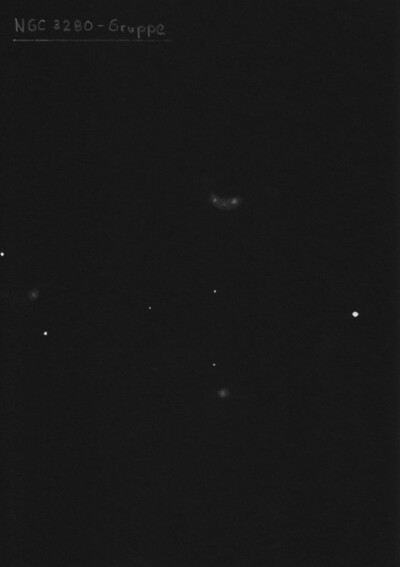
400/500mm - 18" (3/29/03): this is a triple system listed as NGC 3280A/3280B/3280C in NED and NGC 3280/3280A/3280B in the second edition of the Uranometria DSFG. At 262x there was a confused glow, ~1' diameter. Within the glow, two small knots (NGC 3280w and NGC 3280e), ~0.4' and 0.3' were resolved, oriented E-W, with the larger component on the west side (separation is 40" between centers). At moments there was a impression of the very small and faint third component squeezed between these two galaxies. In a small group with NGC 3296 4.8' S and NGC 3297 7.1' ESE. Located 4.6' NE of a mag 9.5 star.
Notes by Steve Gottlieb
NGC 3923
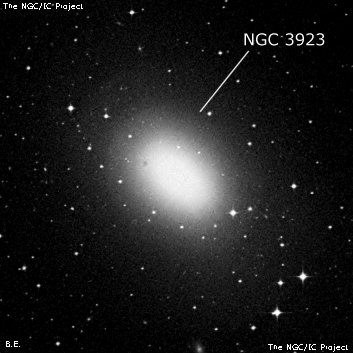
William Herschel discovered NGC 3923 = H I-259 = h3366 on 7 Mar 1791 (sweep 998) and logged "cB, pL, gbM, lE, the brightness takes up a large space of it." His position is at the southwest edge of the galaxy. John Herschel made two observations, first logging "B, pL, lE, glbM, 80" long, 50" broad, resolvable."
200/250mm - 8" (5/21/82): bright, moderately large, elongated SW-NE, small bright nucleus. NGC 3904 lies 40' SW.
400/500mm - 18" (4/29/06): very bright, fairly large, elongated 3:2 SW-NE, ~2.5'x1.5'. Well-concentrated with a very bright elongated core that increases to a stellar nucleus. The relatively fainter halo increases in size with averted vision. This well-studied galaxy is surrounded by concentric gaseous shells of material.
600/800mm - 24" (4/13/18): at 200x; very bright, large, oval ~2:1 SW-NE. Sharply concentrated with a very bright and very small core that seems mottled, highlighted by a stellar nucleus. A very faint star is situated at the southwest edge of the core. The core is surrounded by a large, much fainter oval halo that increases in size with averted vision and extends at least 4'x2'.
Supernova 2018aoz, discovered on April 2 (11 days ago) was surprisingly bright at mag ~13.0 and very easy to identify 3.7' N of center. It was clearly brighter than a mag 13.5 star superimposed at the southwest edge of the halo.
Notes by Steve Gottlieb
NGC 3585
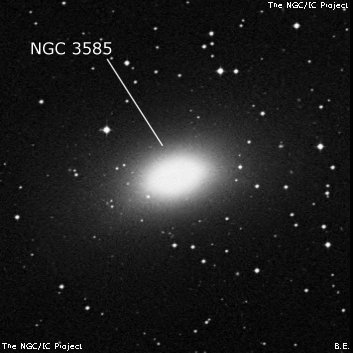
William Herschel discovered NGC 3585 = H II-269 = h3328 on 9 Dec 1784 (sweep 676) and noted "pB, pL, lE, mbB." His position at the south edge of the galaxy. John Herschel made two observations from the CGH and first logged "vB, pL, pmE; forms equilateral triangle with two stars 8th and 8-9 mag following, distant 6' or 7'." Joseph Turner made a sketch on 13 Apr 1877 with the 48" Melbourne Telescope showing it as nearly edge-on WNW-ESE with a small bright nucleus.
400/500mm - 17.5" (4/6/91): very bright, fairly small, elongated 2:1 WNW-ESE, very high surface brightness, very bright core, stellar nucleus. Two mag 13.5 stars are 2.5' NE and 3.3 ' NNW. Forms the western vertex of a near equilateral triangle with two mag 8.5 stars (SAO 179663 and 179667) 8.4' E and 8.4' SE.
Notes by Steve Gottlieb
HCG 42
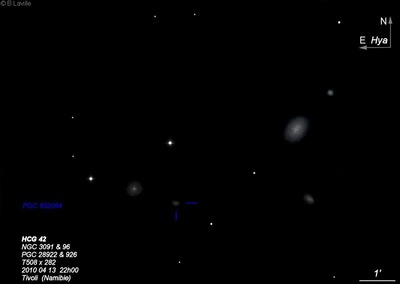
| Type | GALCL [E1] |
| RA | 10:00:21.8 |
| Dec | -19:38:57.0 |
| major_axis | 7.8' |
| mag | 10.6 |
| surface_bright | 99.9 |
HCG 40
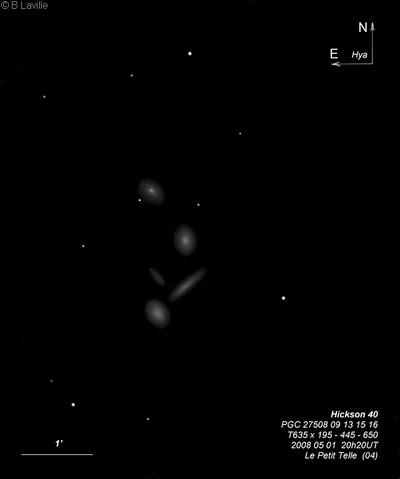
| Type | GALCL [E2] |
| RA | 09:38:54.5 |
| Dec | -04:51:07.0 |
| major_axis | 2.2' |
| mag | 11.4 |
| surface_bright | 99.9 |
HCG 48
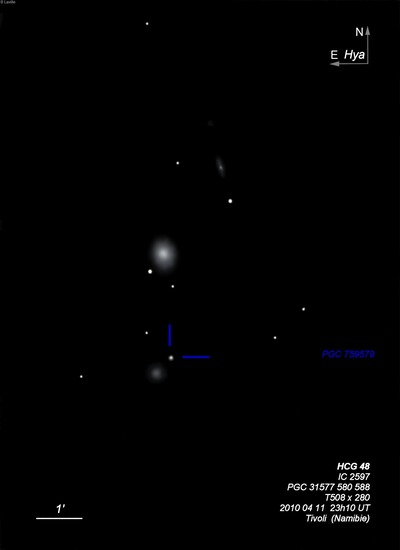
| Type | GALCL [E1] |
| RA | 10:55:48.2 |
| Dec | -27:05:15.0 |
| major_axis | 6.5' |
| mag | 11.6 |
| surface_bright | 99.9 |
Abell 35
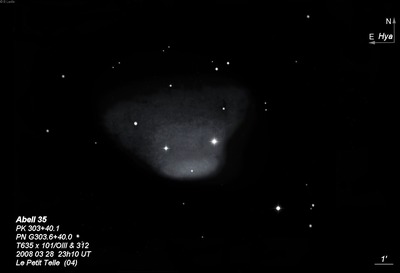
| Type | PN [3a] |
| RA | 12:53:32.8 |
| Dec | -22:52:23.0 |
| major_axis | 12.8' |
| mag | 12.0 |
| surface_bright | 17.3 |
K 1-22
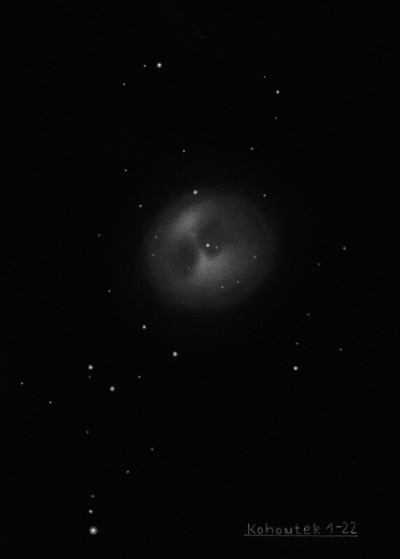
| Type | PN |
| RA | 11:26:43.8 |
| Dec | -34:22:11.0 |
| major_axis | 3.0' |
| mag | 12.1 |
| surface_bright | 14.2 |
HCG 65
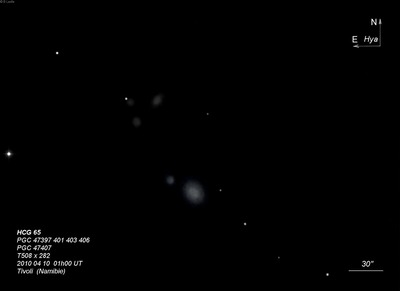
| Type | GALCL [E1] |
| RA | 13:29:53.9 |
| Dec | -29:29:59.0 |
| major_axis | 2.2' |
| mag | 12.7 |
| surface_bright | 99.9 |
Abell 33
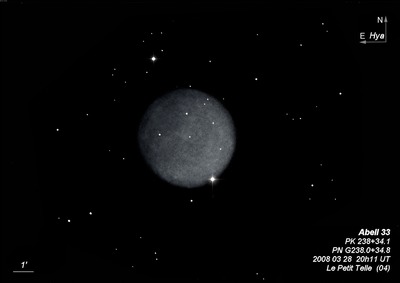
| Type | PN [2b] |
| RA | 09:39:09.1 |
| Dec | -02:48:30.0 |
| major_axis | 4.5' |
| mag | 13.4 |
| surface_bright | 16.4 |
HCG 39
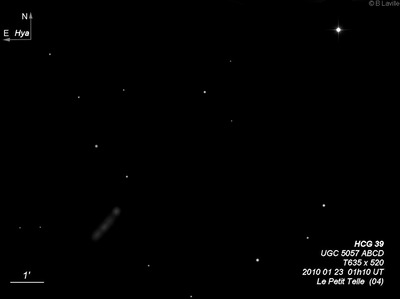
| Type | GALCL [E2] |
| RA | 09:29:28.9 |
| Dec | -01:20:40.0 |
| major_axis | 78.0'' |
| mag | 13.9 |
| surface_bright | 99.9 |
UGC 4638
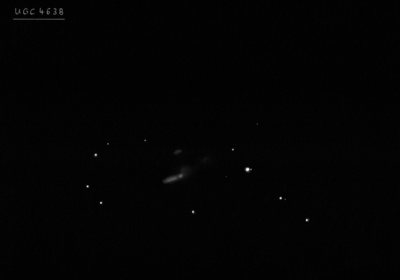
| Type | GX |
| RA | 08:51:38.0 |
| Dec | -02:21:15.0 |
| major_axis | 90.0'' |
| minor_axis | 48.0'' |
| position_angle | 56.0 |
| mag | 14.0 |
Abell 34
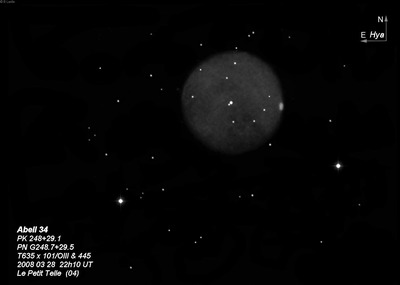
| Type | PN [2b] |
| RA | 09:45:35.3 |
| Dec | -13:10:16.0 |
| major_axis | 4.7' |
| mag | 14.5 |
| surface_bright | 17.6 |